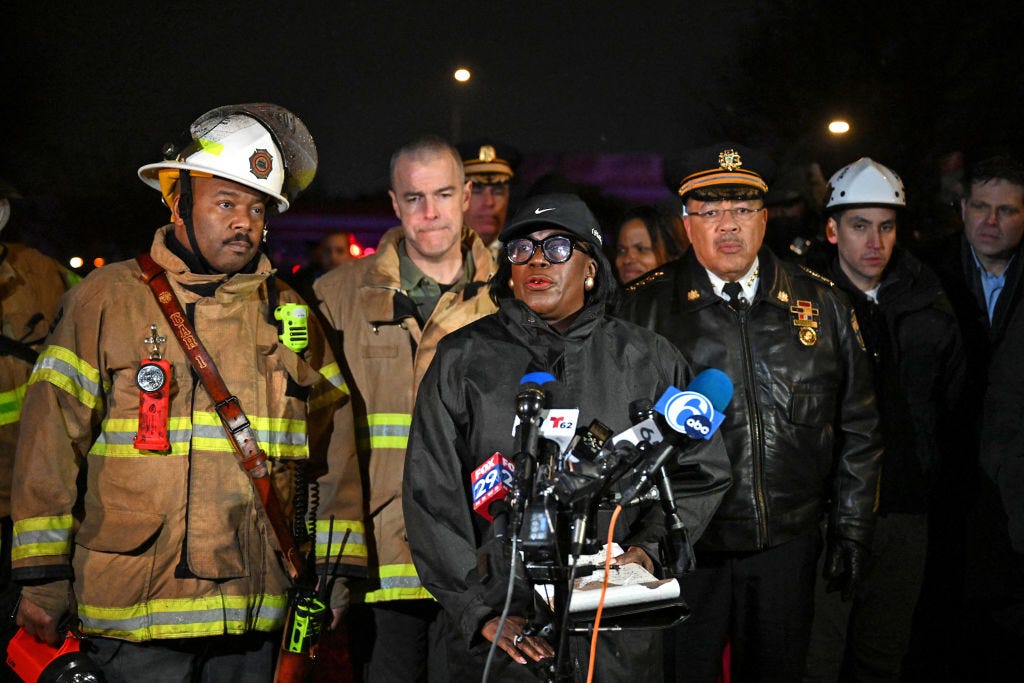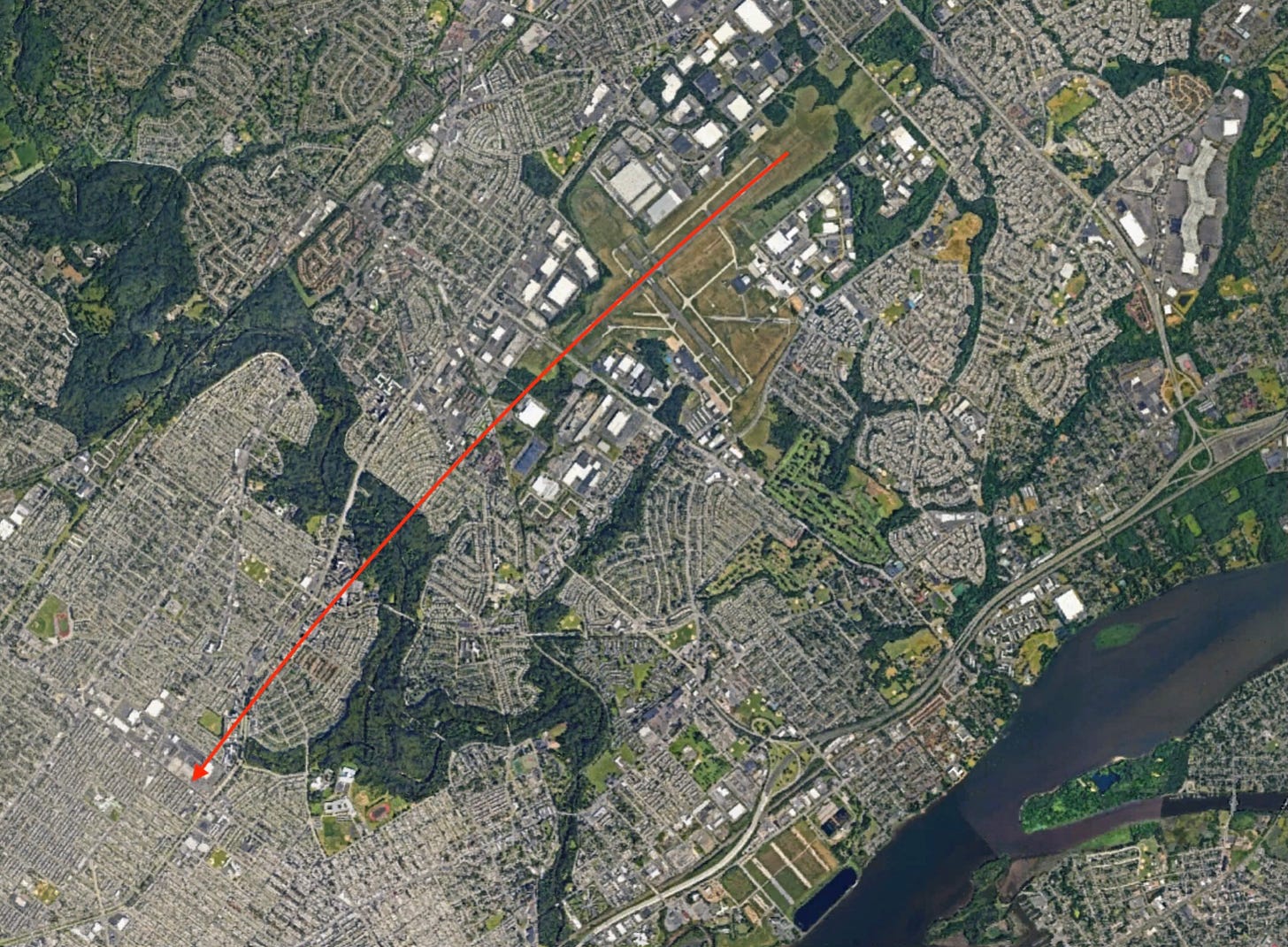Another Bad Day for Aviation.
And how it sounds when often-derided public servants cope with terrible events.
The mayor of Philadelphia, Cherelle Parker, and colleagues earlier this evening, after a Learjet crashed into a neighborhood in Philadelphia. (Photo by KRISTON BETHEL/AFP via Getty Images)
This post has one purpose only. That is to provide a real-time sample of how it sounds when unheralded public employees, whose names the general public will never know, do their work with unflappable competence, knowing that others’ lives are at stake.
Some of these people have recently been the objects of wholly unwarranted abuse, from powerful figures in government who know virtually nothing about these employees’ responsibilities and achievements. (Of course I am talking about Donald Trump and his minions, with their despicable slurs yesterday against today’s “DEI” aviation work force.) I’d like to share this little glimpse of why people in this system have my respect.
The example below comes from this evening’s horrific crash of a twin-engine Learjet 55, operated by Jet Rescue Air Ambulance and apparently flying a medical-transport mission to Missouri. Just after dusk, it took off from Northeast Philadelphia Airport, or PNE, a major general-aviation (that is, non-airline) airport about 15 miles from Philadelphia’s downtown. Almost immediately after takeoff, it plunged straight down in flames into a city neighborhood, near the corner of Roosevelt Boulevard and Cottman Avenue. No one yet has any idea why.
Here’s the general idea of what we’re talking about, from an annotated screenshot on Google Earth. The red arrow shows the plane’s takeoff route, starting in the upper right corner and following PNE’s Runway 24 toward the southwest. The arrow then leads to its impact point, less than 3 miles away.
Soon, we’ll return to this week’s other news-making East Coast aviation disaster: the collision on Wednesday night between a regional jet and an Army helicopter, over the Potomac River in DC. After every aerial disaster, it takes time to weigh evidence and dismiss false leads. One thing we’ve learned for sure since my update last night is that air-traffic controllers in Washington twice alerted the helicopter crew to possible converging traffic, and twice the crew replied “traffic in sight” and said they would maintain “visual separation.” (Presumably they had eyes on a different airplane.) There’s also been more reason to wonder how much traffic—commercial, military, private, otherwise—this crowded airspace can bear. And there is every reason to conclude that Donald Trump’s instant declaration that this was a “DEI crash” reflected nothing but pure bigotry.
What do today’s air-traffic controllers sound like? The clip below, which I’ve just downloaded from the indispensable LiveATC.Net, will let you hear for yourself. (Thanks to fellow Cirrus pilot L.B. for a lead to this recording.)
This is how it sounded a few hours ago, when the air-ambulance Learjet took off and came to grief. Bear in mind when listening that this recording overlays several simultaneous separate radio feeds, all bearing on this flight. (For aviation people: they are PNE tower, PNE ground, and Philly approach/departure, plus at least one transmission from the doomed Learjet pilot.) Sometimes the voices talk over one another, but that is how it was in real time too.
[UPDATE: I am not taking the time now to merge six separate, short M4a sound files into one continuous clip. But if you click, in order from one to six, on the files embedded below, you will hear all the “action” part of the transmissions concerning this tragedy. They’re listed and linked at this footnote1 below.]
The first voice you’ll hear is that of the tower controller at PNE, as he clears the Learjet for takeoff. He uses the plane’s call sign “Medevac Med Service Zero-Five-Six.” Takeoff clearance is the main business in the initial minute of the clip. At about the one-minute mark, you’ll also hear overlapping comments from the “Philly departure” controller, as she handles other airplanes in the area and before she assumes responsibility for the Learjet.
Then, what to listen for:
At around time 2:15, the PNE tower controller tells the Learjet, “Contact Philly departure.” This is a routine instruction after takeoff, as the plane switches from the local control tower to an area-wide controller.
A few seconds later, at around time 2:22, the Learjet pilot acknowledges the call, and says he will switch to Philly Departure. This is the last time we hear that pilot’s voice.
Starting around time 3:10, the controllers begin to wonder what is going on. Normally by around time 2:35—that is, ten or fifteen seconds after the handoff instructions—you’d hear the pilot checking in with Philly departure. But at 3:12, the tower controller re-issues the instruction to switch to Philly Departure. I can hear him beginning to wonder: Is something wrong?
Starting at around time 3:40, you hear both controllers broadcasting at the same time. The original PNE tower controller, and Philly departure, are both putting out calls at the same time (on different frequencies, but overlapped here). They are wondering where the plane is and why the pilot hasn’t checked in.
By this time the plane has crashed. But the controllers know only what they are not hearing over the radio.
Listen to how hard the controllers try to make contact with the plane, from around 3:50 onward.Starting at time 4:39, the controllers switch seamlessly to “managing an emergency” mode. They begin re-directing the other planes that had been inbound to PNE, and sending them to other airports. They cancel takeoff clearances for planes lined up at PNE and ready to depart. They declare the airport closed, and they begin asking inbound pilots whether they have enough fuel to reach other destinations. (For instance, around time 8:00 and again around time 10:00 and 11:40 and 16:40.) If you keep listening, you’ll hear part of a major city’s airspace re-arranged in real time.
I’ve left the whole clip in real time, rather than editing out the dead air. I find the drama gripping, and the participants admirable.
We don’t know what happened to the Learjet, and why it came to grief. I know that people like the ones you hear—public employees, serving the public—did their jobs, under stress, very well.
Here are the short embedded files. If you click one by one, in order, you’ll hear all the relevant parts of the exchanges.
Number one:
Number two:
Number three:
Number four:
Number five:
Number six:






Today, a reporter interviewed me about the fascist attempt to destroy the FBI. Not that I have a LOT of love for the FBI, though I have encountered many people in the bureau whom I respect greatly. But I made a comment (I don't know if it aired; if I could watch and listen to myself, I might be the Dodger broadcaster) that if you have a cold, you don't call a plumber; if you have a clogged drain, you don't call a doctor. Our country has increasingly doubted expertise. James Fallows reminds us that people who know what they're doing matter. A lot.
Thank you for highlighting and lauding what these folks do while dodging the insults and slurs from the folks in the right-wing DEI program, folks who lack morals, ethics, empathy, expertise, you name the quality. Ironically, this is why I made a bunch of tee shirts for my team of VA MDs, shirts which say “another useless government employee.” I’ve been a physician for 30 years in the state and federal government systems, with private sector gigs on the side. The work at the VA is the most fulfilling, even more so whenever the kakistocracy doubles down on the disrespect. We try twice as hard to be perceived as half as good. Thank you for shining a light on these heroes. Any of Trump’s minions wouldn’t last a minute doing these folks’ jobs.